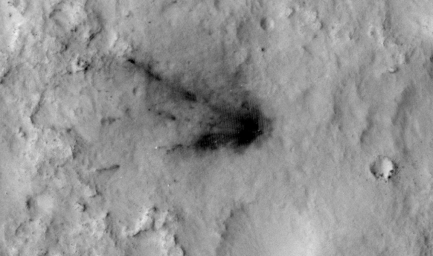 A series of observations from Mars orbit show how dark blast zones that were created during the August 2012 landing of NASA’s Curiosity rover have faded inconsistently. The High Resolution Imaging Science Experiment (HiRISE) camera on NASA’s Mars Reconnaissance Orbiter made the observations on multiple dates from landing to last month. After fading for about two years, the pace of change slowed and some of the scars may have even darkened again.
A series of observations from Mars orbit show how dark blast zones that were created during the August 2012 landing of NASA’s Curiosity rover have faded inconsistently. The High Resolution Imaging Science Experiment (HiRISE) camera on NASA’s Mars Reconnaissance Orbiter made the observations on multiple dates from landing to last month. After fading for about two years, the pace of change slowed and some of the scars may have even darkened again.
The images track changes in blast zones at four locations caused by different pieces of Curiosity hardware, such as the heat shield and the descent stage. The four series, each with images from five to seven different dates since landing, are available online at:
http://www.jpl.nasa.gov/spaceimages/details.php?id=PIA19159
“Spacecraft like Curiosity create these dark blast zone patterns where bright dust is blown away by the landing,” said Ingrid Daubar, a HiRISE team scientist at NASA’s Jet Propulsion Laboratory, Pasadena, California, who has used similar blast zones to find fresh meteor impact sites on Mars. “We expected to see them fade as the wind moved the dust around during the months and years after landing, but we’ve been surprised to see that the rate of change doesn’t appear to be consistent.”
Abstract of talk by Daubar at 46th Lunar and Planetary Science Conference, March 2015, is here (PDF). [More at links]








